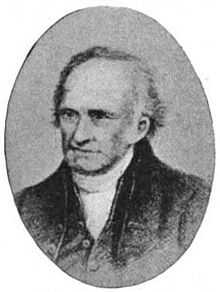Joseph Marsh

Joseph Marsh (January 12, 1726—February 9, 1811) was a Vermont officer in the American Revolution and a government leader who served as Lieutenant Governor.
Biography
Joseph Marsh was born in Lebanon, Connecticut on January 12, 1726. He moved to Hartford, Vermont in 1772 and was a prominent farmer, landowner and businessman.[1]
Marsh took part in the American Revolution, commanding a militia regiment as Lieutenant Colonel and Colonel, and took part in the garrisoning of Fort Ticonderoga after its capture from the British, as well as the Battle of Bennington. In 1777 he took part in the New York Provincial Congress. (At the time, authority over Vermont was the subject of dispute between New Hampshire and New York).[2]
In 1777 Marsh was a member of the Windsor convention that enacted the Constitution forming the Vermont Republic, and served as the convention's Vice President.[3]
In 1778 he was elected Lieutenant Governor, the first individual to hold the office, and he served until 1779. Also in 1778 Marsh was appointed Judge of the Confiscation Court for eastern Vermont. (The confiscation courts were formed to rule on whether defendants were loyal to the United States. Those determined to be Tories had their property confiscated so it could be sold at auction to support the operation of Vermont's government.)[4]
From 1781 to 1782 Marsh was a member of the Vermont House of Representatives.[5]
In 1785 Marsh was a member of Vermont's Council of Censors.[6]
From 1787 to 1795 Marsh served as Judge of the Windsor County Court. He also returned to the Lieutenant Governor's office in 1787, serving until 1790.[7]
Marsh died in Quechee, Vermont on February 9, 1811.[8][9] He was buried in Quechee's Hilltop Cemetery.[10]
Marsh's descendants included his son Charles Marsh and grandsons James Marsh and George Perkins Marsh.[11][12]
References
- ↑ Men of Vermont: An Illustrated Biographical History of Vermonters and Sons of Vermont, compiled by Jacob G. Ullery, 1894, pages 62 to 63
- ↑ History of Windsor County, Vermont, edited by Lewis Cass Aldrich and Frank R. Holmes, pages 83 to 84
- ↑ Early History of Vermont, by LaFayette Wilbur, Volume 2, 1900, pages 371 to 372
- ↑ History of Hartford, Vermont, July 4, 1761 -- April 4, 1889, by William Howard Tucker, 1889, pages 371 to 372
- ↑ Records of the Governor and Council of the State of Vermont, published by E. P. Walton, Montpelier, Volume 1, 1873, pages 236 to 238
- ↑ Gazetteer and Business Directory of Windsor County, Vt., for 1883-84, compiled and edited by Hamilton Child, 1884, pages 129 to 130
- ↑ The Geography, History, Constitution and Civil Government of Vermont, by Edward Conant and Mason Sereno Stone, 1915, page 321
- ↑ Memorial Address on the Life and Character of the Hon. Charles Marsh, by James Barrett, 1871, page 53
- ↑ Year book, published by Society of Colonial Wars in the State of Vermont, 1912, page 245
- ↑ Personal observation and gravestone photograph by Find A Grave contributor Cynthia Kaley, July 30, 2007, accessed December 23, 2011
- ↑ George Perkins Marsh: Prophet of Conservation, by David Lowenthal, 2003, pages 7 to 8
- ↑ The University of Vermont: The First Two Hundred Years, by Robert Vincent Daniels, 1991, page 63
| Preceded by New position |
Lieutenant Governor of Vermont (Independent Republic) 1778–1779 |
Succeeded by Benjamin Carpenter |
| Preceded by Paul Spooner |
Lieutenant Governor of Vermont (Independent Republic) 1787–1790 |
Succeeded by Peter Olcott |